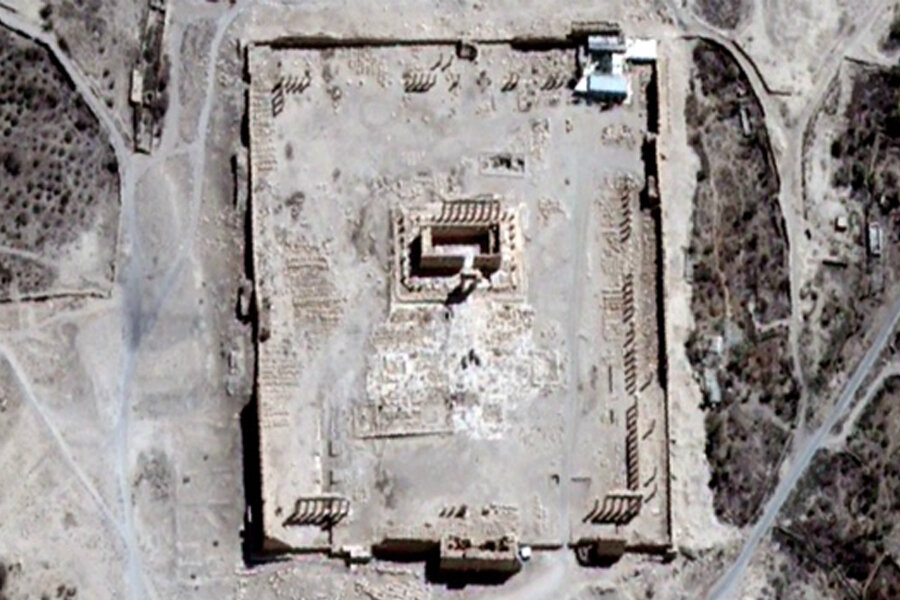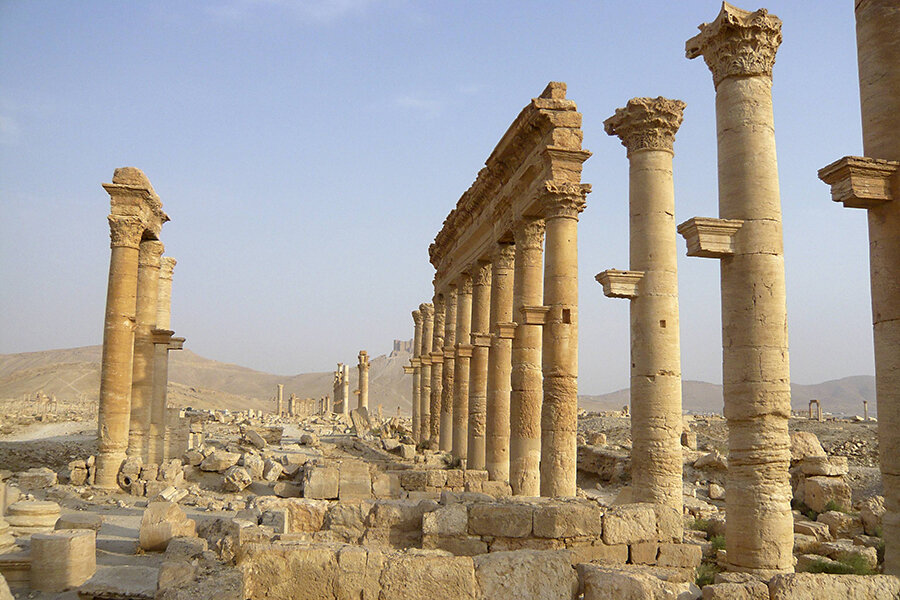Why ISIS blew up Syria's iconic Bel temple
Loading...
| Istanbul, Turkey
UN satellite images of the Temple of Bel in the sprawling archaeological complex of Palmyra shows that Islamic State militants succeeded in blowing up most of the structure.
“We can confirm the destruction of the main building of the Temple of Bel as well as a row of columns in its immediacy,” reported the Geneva-based United Nations Institute for Training and Research.
The act comes right on the heels of the destruction of another temple and the murder of world-renowned scholar Khaled al-Asaad, who spent a lifetime promoting and preserving the ruins.
Palmyra residents contacted on social media described hearing a large explosion on Sunday. Since the ruins are largely off limits, however, they were unable to photograph the damage up close.
Maher Mohammed al-Aid, who served as the custodian of the temple for 25 years, fled to Turkey after militants from the self-described Islamic State killed Mr. Asaad, his colleague, two weeks ago. He says militants did not display any interest in the ruins when they first arrived in May, and that he never imagined the ruins would be destroyed with such "barbarism."
"I don't drink, but after hearing the news I drank arak [an alcoholic spirit]," he told the Monitor. "This is worse than the barrel bombs of [Syrian President] Bashar [al-Assad]. Palmyra is gone, history now. They left nothing."
Propaganda value
IS has yet to release its own images of the temple, but the group appears to be stepping up its destruction of such sites for propaganda purposes, signaling to its supporters that its power is unbridled after a year of US-led airstrikes in Iraq and Syria.
The temple is considered among the most important at Palmyra, which IS seized in May from Syrian forces. The Sunni jihadist group initially focused on killing regime loyalists and imposing their archaic interpretation of Islam on the local population. Two weeks ago, it murdered Khalid al-Assad, an 82-year-old antiquities scholar in Palmyra. Now it appears determined to dynamite the town’s Roman-era ruins in the face of global calls for it to be spared.
“They are destroying Palmyra for ideological and propaganda reasons,” says Syria’s antiquities director, Maamoun Abdulkarim, who is based in Damascus. “The next stage will be worse. We have nothing in our hearts but fear and pessimism.”
The director said local residents had sought to persuade IS not to destroy the Bel temple by stressing its use as a Muslim place of worship in recent history. IS militants view the temple as idolatrous because it was dedicated to a Semitic god worshiped as the master of heaven. It later served as a fort and a church.
An activist from Palmyra said there was a large explosion at the site of Bel temple on Sunday afternoon. “Nothing but the outer walls was left,” he said via Facebook. His group was the first to report the destruction of another temple called Baalshamin on Twitter earlier this month, before IS released its own propaganda images. The group hasn’t yet released any images of Bel.
“The Bel Temple is the Bamiyan of Palmyra,” says Cheikmous Ali, founder of the Association for the Protection of Syrian Archaeology. Carved into sandstone cliffs in eastern Afghanistan, the giant Buddhas of Bamiyan were dynamited and destroyed by the Taliban in 2001.
Compared to the Taliban, which was ousted in 2001 by US-backed forces, IS has taken the destruction of world heritage for the purposes of ideology and terror to a whole new level. IS militants have systematically demolished pagan, Christian, and even Muslim sites in areas of Iraq and Syria under their control.
IS “aims to destroy the memory of the Syrian people,” says Mr. Ali, adding that Palmyra is one of many heritage sites in Syria damaged after more than four years of conflict.
Attacks and antiquity trades
In August, IS stepped up its attacks on Syrian heritage, bulldozing the monastery of Mar Elian after seizing the town of Qaryyatain. But the group is also known to be trading antiquities with foreign buyers, part of a larger network of smugglers profiting from the chaos in Syria.
“They loot what they can sell and they will destroy what they cannot,” says Amr Al-Azm, professor of Middle East history and anthropology at Shawnee State University in Ohio.
Blowing up the Bel Temple, he says, qualifies as an “atrocity class action” that sends a powerful propaganda message to its support base and the international community. He argues that this and the destruction of ancient artifacts in the museum of Mosul in Iraq are on par with Islamic State’s videotaped murders of foreign journalists and the drowning of caged prisoners.
Such actions often come in the wake of military setbacks and have dual purposes, says Mr. Al Azm. “It highlights the ability of IS to act with impunity and it also demonstrates the impotence of the international community to respond to IS atrocities. That combination is a very powerful propaganda message.”
The group has not suffered any major defeats since June when it lost the strategic Syrian border town of Tel Abyad to coalition-backed Kurdish forces. But it may be entering a phase of greater international pressure: Turkey said on Friday it had carried out its first airstrikes against the group. Turkey is also pushing for a buffer zone in northern Syria.
Al Azm says that Palmyra could serve as a sanctuary from airstrikes because the US-led coalition is loathe to bomb inside an archaeological zone. It already uses other ancient structures like the Byzantine Resafa Palace in Alqala and Jaabr Castle outside Tabqah as military barracks. Given the wealth of ruins in Palmyra, “they can afford to destroy a few pieces to attract attention and still use it as a safe haven,” he says.








